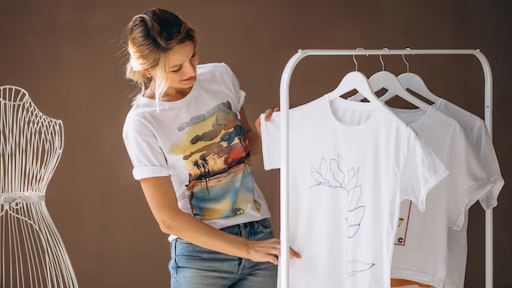In today’s crowded marketplace, standing out isn’t just about having a great product—it’s about creating a memorable brand experience at every touchpoint. One of the most underutilized yet highly effective tools for achieving this?
Custom apparel. Far beyond basic logo tees, thoughtfully designed branded clothing can become a dynamic extension of your identity, values, and mission. When done right, it doesn’t just dress your team or customers—it tells your story, builds community, and reinforces trust.
Why Custom Apparel Matters for Modern Brands
Custom apparel is more than promotional merchandise. It’s a wearable representation of your brand’s personality. Whether you’re outfitting employees, launching a limited-edition product line, or gifting loyal clients, every garment becomes a mobile billboard—one that carries emotional weight and visual consistency.
For small and mid-sized businesses, especially, custom clothing offers a cost-effective way to:
- Strengthen brand recognition through consistent visual identity
- Foster team unity and pride among employees
- Enhance customer loyalty by offering exclusive, personalized items
- Communicate values (like sustainability or innovation) through fabric choice and design
Unlike digital ads that disappear with a scroll, apparel lives in the real world—on streets, at events, in social media photos—creating organic, long-term visibility.
Step 1: Define Your Brand Story First
Before selecting colors or cuts, ask: What do we want our clothing to say? Your apparel should reflect your core message. A wellness brand might choose soft, earth-toned organic cotton to signal calm and sustainability. A tech startup could opt for sleek, modern silhouettes with minimalist typography to convey innovation.
This alignment between brand ethos and garment design is what transforms a simple T-shirt into a storytelling vehicle. Every detail—fabric, fit, print technique, even packaging—should feel intentional and on-brand.
Step 2: Prioritize Quality Over Quantity
Low-cost, mass-produced apparel may save money upfront, but often backfires. Poor stitching, fading prints, or uncomfortable materials can dilute your brand’s perceived value. Instead, invest in high-quality materials and ethical production. Not only does this ensure longevity and wearability, but it also signals that your brand cares about craftsmanship and responsibility—key drivers of consumer trust in 2024 and beyond.
Look for suppliers who offer:
- OEKO-TEX® or GOTS-certified fabrics
- Transparent manufacturing practices
- Options for small-batch production (ideal for testing designs or seasonal drops)
Step 3: Design for Real People, Not Just Logos
Too many brands slap their logo on a chest and call it “branded apparel.” True brand experience comes from human-centered design. Consider:
- Fit inclusivity: Offer a range of sizes and gender-neutral options
- Functionality: Will your team wear this all day? Is it breathable, durable, and comfortable?
- Aesthetic cohesion: Does the design complement your website, packaging, and social media visuals?
Subtlety often wins. A small embroidered logo on the sleeve, a custom interior neck tag with your mission statement, or a unique color palette inspired by your brand guidelines can feel elevated and intentional—never corporate or generic.
Step 4: Use Apparel Strategically Across Touchpoints
Best custom apparel shines when integrated into broader brand strategies:
- Employee uniforms: Turn staff into confident brand ambassadors
- Customer rewards: Offer exclusive apparel as part of loyalty programs
- Event merchandise: Create limited-run pieces for launches or conferences
- Product extensions: Sell branded apparel as a revenue stream (e.g., “Wear the Mission” collections)
Each use case deepens engagement. A customer who wears your hoodie isn’t just making a purchase—they’re publicly aligning with your values.
Step 5: Leverage Flexible Payment Terms for Smoother Scaling
For growing businesses, cash flow is critical. Look for partners that offer Net 30 payment terms—a game-changer that allows you to receive and even distribute apparel before payment is due. This flexibility means you can:
- Launch seasonal collections without upfront capital
- Fulfill large orders for events or retail without straining budgets
- Test new designs with minimal financial risk
Such terms reflect a supplier’s confidence in your business and their commitment to your mutual success—a hallmark of true partnership.
The Bigger Picture: Apparel as Emotional Branding
People don’t just buy what you do—they buy why you do it. Custom apparel, when crafted with purpose, becomes a tactile expression of that “why.” It invites wearers into your world, creating a sense of belonging that transcends transactions.
In fact, studies show that employees who wear branded apparel report higher morale and brand alignment. Meanwhile, customers who receive or purchase high-quality branded items are more likely to share them on social media—amplifying reach organically.
Final Thoughts
Custom apparel isn’t a one-time marketing tactic. It’s a strategic asset that, when executed with clarity and care, builds lasting brand equity. By focusing on storytelling, quality, inclusivity, and smart financial planning, you can turn every garment into a meaningful brand experience—one that’s seen, felt, and remembered.
Whether you’re a startup building your identity or an established business refreshing your image, remember: the right piece of clothing doesn’t just cover the body—it carries your brand into the world.

